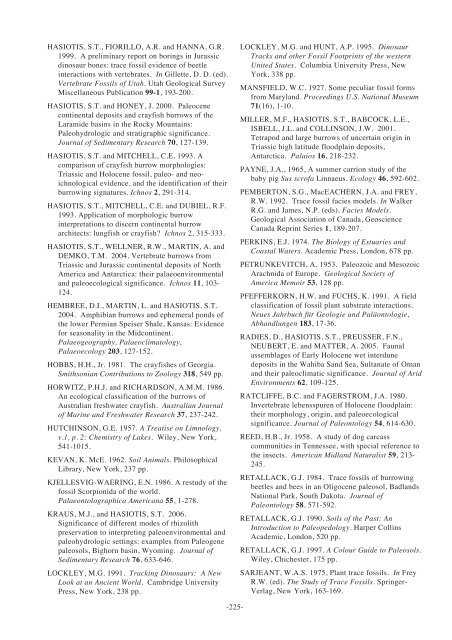Continental trace fossils and museum exhibits - Geological Curators ...
Continental trace fossils and museum exhibits - Geological Curators ...
Continental trace fossils and museum exhibits - Geological Curators ...
You also want an ePaper? Increase the reach of your titles
YUMPU automatically turns print PDFs into web optimized ePapers that Google loves.
HASIOTIS, S.T., FIORILLO, A.R. <strong>and</strong> HANNA, G.R.1999. A preliminary report on borings in Jurassicdinosaur bones: <strong>trace</strong> fossil evidence of beetleinteractions with vertebrates. In Gillette, D. D. (ed).Vertebrate Fossils of Utah. Utah <strong>Geological</strong> SurveyMiscellaneous Publication 99-1, 193-200.HASIOTIS, S.T. <strong>and</strong> HONEY, J. 2000. Paleocenecontinental deposits <strong>and</strong> crayfish burrows of theLaramide basins in the Rocky Mountains:Paleohydrologic <strong>and</strong> stratigraphic significance.Journal of Sedimentary Research 70, 127-139.HASIOTIS, S.T. <strong>and</strong> MITCHELL, C.E. 1993. Acomparison of crayfish burrow morphologies:Triassic <strong>and</strong> Holocene fossil, paleo- <strong>and</strong> neoichnologicalevidence, <strong>and</strong> the identification of theirburrowing signatures. Ichnos 2, 291-314.HASIOTIS, S.T., MITCHELL, C.E. <strong>and</strong> DUBIEL, R.F.1993. Application of morphologic burrowinterpretations to discern continental burrowarchitects: lungfish or crayfish? Ichnos 2, 315-333.HASIOTIS, S.T., WELLNER, R.W., MARTIN, A. <strong>and</strong>DEMKO, T.M. 2004. Vertebrate burrows fromTriassic <strong>and</strong> Jurassic continental deposits of NorthAmerica <strong>and</strong> Antarctica: their palaeoenvironmental<strong>and</strong> paleoecological significance. Ichnos 11, 103-124.HEMBREE, D.I., MARTIN, L. <strong>and</strong> HASIOTIS, S.T.2004. Amphibian burrows <strong>and</strong> ephemeral ponds ofthe lower Permian Speiser Shale, Kansas: Evidencefor seasonality in the Midcontinent.Palaeogeography, Palaeoclimatology,Palaeoecology 203, 127-152.HOBBS, H.H., Jr. 1981. The crayfishes of Georgia.Smithsonian Contributions to Zoology 318, 549 pp.HORWITZ, P.H.J. <strong>and</strong> RICHARDSON, A.M.M. 1986.An ecological classification of the burrows ofAustralian freshwater crayfish. Australian Journalof Marine <strong>and</strong> Freshwater Research 37, 237-242.HUTCHINSON, G.E. 1957. A Treatise on Limnology,v.1, p. 2: Chemistry of Lakes. Wiley, New York,541-1015.KEVAN, K. McE. 1962. Soil Animals. PhilosophicalLibrary, New York, 237 pp.KJELLESVIG-WAERING, E.N. 1986. A restudy of thefossil Scorpionida of the world.Palaeontolographica Americana 55, 1-278.KRAUS, M.J., <strong>and</strong> HASIOTIS, S.T. 2006.Significance of different modes of rhizolithpreservation to interpreting paleoenvironmental <strong>and</strong>paleohydrologic settings: examples from Paleogenepaleosols, Bighorn basin, Wyoming. Journal ofSedimentary Research 76, 633-646.LOCKLEY, M.G. 1991. Tracking Dinosaurs: A NewLook at an Ancient World. Cambridge UniversityPress, New York, 238 pp.LOCKLEY, M.G. <strong>and</strong> HUNT, A.P. 1995. DinosaurTracks <strong>and</strong> other Fossil Footprints of the westernUnited States. Columbia University Press, NewYork, 338 pp.MANSFIELD, W.C. 1927. Some peculiar fossil formsfrom Maryl<strong>and</strong>. Proceedings U.S. National Museum71(16), 1-10.MILLER, M.F., HASIOTIS, S.T., BABCOCK, L.E.,ISBELL, J.L. <strong>and</strong> COLLINSON, J.W. 2001.Tetrapod <strong>and</strong> large burrows of uncertain origin inTriassic high latitude floodplain deposits,Antarctica. Palaios 16, 218-232.PAYNE, J.A., 1965, A summer carrion study of thebaby pig Sus scrofa Linnaeus. Ecology 46, 592-602.PEMBERTON, S.G., MacEACHERN, J.A. <strong>and</strong> FREY,R.W. 1992. Trace fossil facies models. In WalkerR.G. <strong>and</strong> James, N.P. (eds). Facies Models.<strong>Geological</strong> Association of Canada, GeoscienceCanada Reprint Series 1, 189-207.PERKINS, E.J. 1974. The Biology of Estuaries <strong>and</strong>Coastal Waters. Academic Press, London, 678 pp.PETRUNKEVITCH, A. 1953. Paleozoic <strong>and</strong> MesozoicArachnida of Europe. <strong>Geological</strong> Society ofAmerica Memoir 53, 128 pp.PFEFFERKORN, H.W. <strong>and</strong> FUCHS, K. 1991. A fieldclassification of fossil plant substrate interactions.Neues Jahrbuch für Geologie und Paläontologie,Abh<strong>and</strong>lungen 183, 17-36.RADIES, D., HASIOTIS, S.T., PREUSSER, F.N.,NEUBERT, E. <strong>and</strong> MATTER, A. 2005. Faunalassemblages of Early Holocene wet interdunedeposits in the Wahiba S<strong>and</strong> Sea, Sultanate of Oman<strong>and</strong> their paleoclimatic significance. Journal of AridEnvironments 62, 109-125.RATCLIFFE, B.C. <strong>and</strong> FAGERSTROM, J.A. 1980.Invertebrate lebensspuren of Holocene floodplain:their morphology, origin, <strong>and</strong> paleoecologicalsignificance. Journal of Paleontology 54, 614-630.REED, H.B., Jr. 1958. A study of dog carcasscommunities in Tennessee, with special reference tothe insects. American Midl<strong>and</strong> Naturalist 59, 213-245.RETALLACK, G.J. 1984. Trace <strong>fossils</strong> of burrowingbeetles <strong>and</strong> bees in an Oligocene paleosol, Badl<strong>and</strong>sNational Park, South Dakota. Journal ofPaleontology 58, 571-592.RETALLACK, G.J. 1990. Soils of the Past: AnIntroduction to Paleopedology. Harper CollinsAcademic, London, 520 pp.RETALLACK, G.J. 1997. A Colour Guide to Paleosols.Wiley, Chichester, 175 pp.SARJEANT, W.A.S. 1975, Plant <strong>trace</strong> <strong>fossils</strong>. In FreyR.W. (ed). The Study of Trace Fossils. Springer-Verlag, New York, 163-169.-225-
















